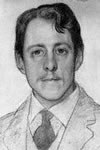
BB. Richard Aldington
3. Images (1910-1915). London: Poetry Bookshop, 1915.
 |
 |
|||
| The ‘Japanese influence’ in Aldington’s Images came by way of Laurence Binyon, a fact unknown to both poets. | ||||
Among the more interesting stories in this study is one that may be pieced together from a letter Aldington wrote to Miner (see 14) that touches on poems in this collection. At least one, THE RIVER (formerly I HAVE DRIFTED ALONG THE RIVER, 2), was based on ukiyoe in the British Museum Print Room, and Aldington notes that along with the prints were translations of the poems that appeared within their borders. He writes that he copied these and ‘kept them for a long time’. Miner speculates that the translations were by Waley (see D26), but Waley did not begin working for the Sub-Department of Oriental Prints and Drawings until 1913, and did not publish a translation from Japanese until after the war. At the time Aldington was working in the Print Room, however, probably between 1912 and 1914, but certainly not later than December 1916 when he left for the front, Binyon had worked in the Department of Prints and Drawings for at least fifteen years, and was Assistant-Keeper in charge of the Sub-Department of Oriental Prints and Drawings. Binyon had published three important books on Japanese art, and was at work on his Catalogue of Japanese and Chinese Woodcuts . . . in the British Museum (BC14), which appeared in 1916 with his own translations of the songs and poems from the Print Room ukiyoe. The translations Aldington copied and ‘kept . . . for a long time’, then, were Binyon’s, though Aldington apparently never knew, and Binyon, who died fifteen years before Miner’s book referred to Aldington’s letter, likewise would not have known that Aldington copied his translations, kept them, and derived poems in his most important collection from them. Miner (A25), Harmer (A51), Megata (BB21), and Smith (BB22) note the resemblance of several of the poems to haiku. The poems noted appear also in two enlarged editions, Images Old and New (Boston: Four Seas, 1916) and Images (London: Egoist, 1919).
a. A Girl, October, and New Love. Printed here as separate poems, but appeared first under one title, Epigrams, in Some Imagist Poets, 1915, and restored to that title in Aldington’s Collected and Complete Poems (11 and 13). Smith notes that in early translations ‘haiku’ was rendered ‘epigram’—see Chamberlain (D5a), Couchoud (D19), and Porter (D20), for example—and suggests that these are examples of ‘more or less conscious’ imitation of the Japanese form. The similarities are limited, though, to approximate length and reliance on concrete imagery. Two other Epigrams appear in Images of Desire (8), and four others written about this time in ‘An Anthology of Uncollected Poems’ (16). Some of these are as similar to haiku as those printed here, but others are ‘epigrams’ in a typically European sense, and so Aldington seems not to have had the Japanese form solely in mind when he chose the title. See also 23.
b. Images. Six three- to five-line verses that like Aldington’s later set of ‘Images’ (see 8) Smith finds ‘comparable’ to tanka. The poems probably are modelled in part on Binyon’s translations from ukiyoe (see above). Appeared first in Poetry 7 (October 1915). See also 23.
c. Evening and London. Smith suggests a ‘marked . . . resemblance to . . . haikai’ in EVENING, and makes a plausible case for the observation, but adds that similarities may be ‘accidental’. He regards the opening five stanzas of LONDON as ‘haikai in English’, and notes the haiku-like seventeen syllables of the first two stanzas, the first of which he finds ‘the most genuine haiku, by Japanese standards, among all of Aldington’s poems’. Aldington probably was working from Japanese models, but to suggest that these are ‘genuine haiku by Japanese standards’ is a misunderstanding. Better put, they are ‘genuine haiku’ by the standards of Flint (Ap) and Pound, though as such they are nonetheless ultimately derived from Japanese originals.

